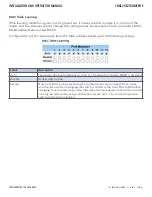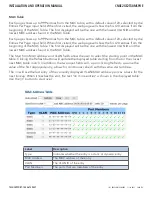
INS_CNXE2GE2TX8MSPOE 11 Jan 2021 PAGE 190
INSTALLATION AND OPERATION MANUAL
CNXE2GE2TX8MSPOE
TECH SUPPORT: 1.888.678.9427
Label
Description
Reserved Power
determined by
There are three modes for configuring how the ports/PDs may reserve power.
Allocated mode: In this mode the user allocates the amount of power that each
port may reserve. The allocated/reserved power for each port/PD is specified in
the Maximum Power fields.
Class mode: In this mode each port automatically determines how much power
to reserve according to the class the connected PD belongs to, and reserves the
power accordingly. Four different port classes exist and one for 4, 7, 15.4 or 30
Watts. In this mode the Maximum Power fields have no effect.
LLDP-MED mode: This mode is similar to the Class mode expect that each port
determine the amount power it reserves by exchanging PoE information using the
LLDP protocol and reserves power accordingly. If no LLDP information is available
for a port, the port will reserve power using the class mode
In this mode the Maximum Power fields have no effect
For all modes: If a port uses more power than the reserved power for the port, the
port is shut down.
Power Management
Mode
There are 2 modes for configuring when to shut down the ports:
Actual Consumption: In this mode the ports are shut down when the actual power
consumption for all ports exceeds the amount of power that the power supply can
deliver or if the actual power consumption for a given port exceeds the reserved
power for that port. The ports are shut down according to the ports priority. If two
ports have the same priority the port with the highest port number is shut down.
Reserved Power: In this mode the ports are shut down when total reserved
powered exceeds the amount of power that the power supply can deliver. In
this mode the port power is not turned on if the PD requests more power than
available from the power supply.
Primary and Backup
Power Source
Some switches support having two PoE power supplies. One is used as primary
power source, and one as backup power source. If the switch doesn’t support
backup power supply only the primary power supply settings will be shown. In
case that the primary power source fails the backup power source will take over.
For being able to determine the amount of power the PD may use, it must be
defined what amount of power the primary and backup power sources can deliver.
Valid values are in the range 0 to 2000 Watts.
Port
This is the logical port number for this row.
Ports that are not PoE-capable are grayed out and thus impossible to configure
PoE for.
PoE Mode
The PoE Mode represents the PoE operating mode for the port.
Disabled: PoE disabled for the port.
PoE : Enables PoE IEEE 802.3af (Class 4 PDs limited to 15.4W)
PoE+ : Enables PoE+ IEEE 802.3at (Class 4 PDs limited to 30W)
Priority
The Priority represents the ports priority. There are three levels of power priority
named Low, High and Critical.
The priority is used in the case where the remote devices requires more power
than the power supply can deliver. In this case the port with the lowest priority will
be turn off starting from the port with the highest port number.
















































